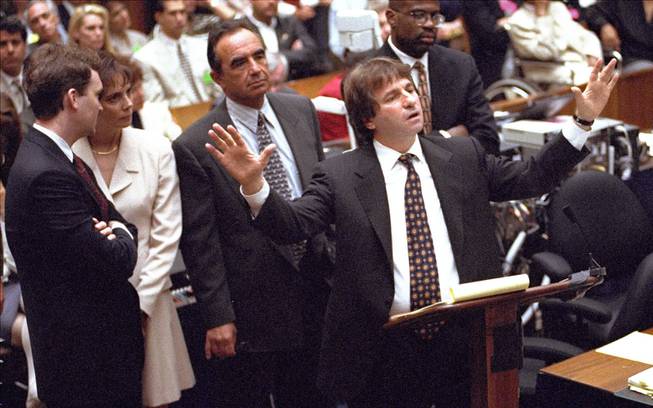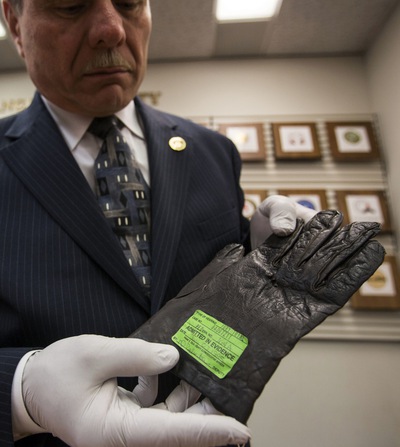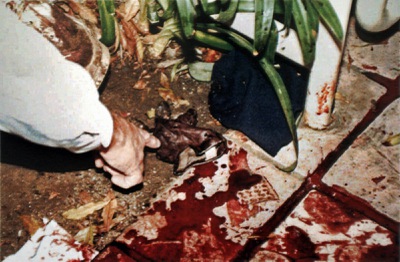
Reed Saxon, Pool / AP File
In this Sept. 15, 1995, file photo, defense attorney Barry Scheck, center, cross examines prosecution witness William Bodziak as, from left, Hank Goldberg, Marcia Clark, Robert Shapiro, and Christopher Darden look on during the O.J. Simpson double-murder trial in Los Angeles. Scheck, the lawyer who introduced the science of DNA to jurors and to the public watching the trial on TV, attacked police methods of evidence collection and demolished the prosecution’s forensic evidence case.
Monday, June 9, 2014 | 2 a.m.
Related Story
The O.J. Simpson murder trial cast a harsh light on police and forensic work, and gave law enforcement a textbook example of what not to do at a crime scene.
At the trial two decades ago, Simpson's defense attorneys poked gaping holes in the prosecution's case by exposing problems the Los Angeles Police Department had in handling evidence. Among the lessons: follow procedure, make sure evidence is always accounted for and properly logged and be brutally honest to a jury even if it hurts.
"If your mission is to sweep the streets of bad people ... and you can't prosecute them successfully because you're incompetent and can't do your job, you've defeated your primary mission," said Mike Williamson, an attorney and a former veteran LAPD officer.
After Simpson was acquitted of killing his ex-wife, Nicole Brown Simpson, and her friend, Ronald Goldman, the LAPD made significant changes in the scientific investigation division, which defense attorney Johnnie Cochran referred to as "a cesspool of contamination" for sloppy evidence-handling.

In this May 30, 2014, photo, Los Angeles County District Attorney senior investigator John Calicchio shows a glove used as evidence in the O.J. Simpson murder case, in the D.A's office in Los Angeles. After Simpson was acquitted of killing his ex-wife, Nicole Brown Simpson, and her friend, Ronald Goldman, the LAPD made significant changes in the scientific investigation division.
As a result of the headlines, the crime lab was provided more funding and additional staff, and it was also accredited in 1997.
"One of our major learning points in the Simpson trial was when we were taken to task. It was difficult to point to notes that we had taken in order to demonstrate that work was done in a certain way," said Doreen Hudson, who now heads the crime lab.
Analysts began to take more detailed notes so that information was memorialized and not left to memory.
Henry Lee, the defense forensic expert during the trial, said that although there was lots of evidence, the source of evidence wasn't always explained and it wasn't closely tracked.
During the case, no one noticed any blood on a pair of socks collected from Simpson's bedroom until two months later at the crime lab. Defense experts suggested blood was smeared on them while they were lying flat not while someone was wearing them.
Police forensic technicians were also faulted by the defense for improperly packaging evidence samples and then leaving them in an overheated van on a summer day. A rookie technician had collected most of the evidence.
The lab now uses barcodes to scan and track evidence. And crime scenes are also more tightly controlled. Trainees like the one who helped at multiple crime scenes in the Simpson case now can only observe the work done by two fully trained criminalists.
"We're more cognizant of contamination or the possibility of contamination or the appearance of contamination — that a jury might toss out some evidence," said Cmdr. Andrew Smith.

This June 13, 1994, file evidence photo provided by the Los Angeles Police Department shows LAPD's Mark Fuhrman pointing to a pieces of evidence near the body of Nicole Brown Simpson on the bloodstained walkway of her condominium. The photo was introduced as evidence and released for publication, in the 1996 O.J. Simpson wrongful-death civil trial. The O.J. Simpson trial has become a textbook example of what not to do at a crime scene for police and forensic workers.
Teams of criminalists overseen by a crime scene manager, who coordinates with detectives, now respond to high-profile and complex crimes, Hudson said.
Another criticism during the trial dealt with a vial of blood taken from Simpson. Police Detective Philip Vannatter drew Simpson's blood at the LAPD on June 13, the day after the killings. But instead of booking it into evidence, Vannatter put the blood vial in his pocket and went to Simpson's home where criminalists were collecting evidence.
Jurors questioned why he would have carried it around for hours rather than booking it and the defense argued it may have been used to plant evidence such as blood drops on Simpson's front walkway.
That would never happen today, Hudson said. Officers still get sidetracked following a suspect or victim to a hospital, for example, before returning to the scene, but today they wouldn't be allowed to re-enter a crime scene with evidence.
Looking back on the case, Hudson said, "the only thing you can do is when something really bad happens is to try to make something good out of it."

Join the Discussion:
Check this out for a full explanation of our conversion to the LiveFyre commenting system and instructions on how to sign up for an account.
Full comments policy